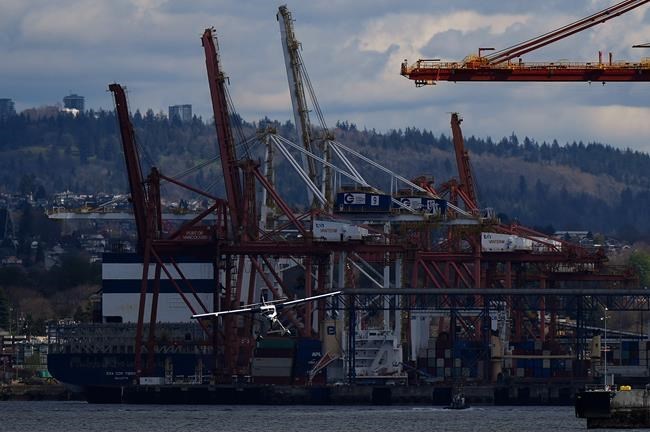The Port of Vancouver placed second-to-last on a global ranking of hundreds of container ports, after some cargo ships waited weeks to unload their cargo last year.
Compiled by the World Bank and S&P Global Market Intelligence, the container port performance index lists Vancouver at No. 347 out of 348 — and dead last among ports of similar size.
The study uses vessel wait times as an indicator of overall efficiency.
The low grade speaks not just to port operations in isolation, but the vast supply network they sit within as well as snarls and bumps specific to Canada.
Strong consumer demand drove a surge of imports to ports all along the west coast of North America in 2021 and 2022, causing congestion that has eased since December, said Vancouver Fraser Port Authority spokesman Alex Munro.
Indeed, eight of the 14 lowest-ranked container ports were in North America, including British Columbia's Prince Rupert, Los Angeles, neighbouring Long Beach and, in last place, Savannah, Ga.
Munro cited additional challenges that included "supply chain congestion" in Ontario and Quebec as well as an "overhang" from flooding in British Columbia in late 2021 that severed Vancouver from the country's transportation network for eight days.
"The last few years have reinforced the need to continue to invest in port infrastructure and technology to accommodate Canada’s growing trade and keep supply chains moving efficiently," Munro said in an email.
In 2022, container volumes at the Vancouver port fell by four per cent year over year amid softer consumer demand and overstocked inventories, but last year’s total still marked its third-highest amount on record.
Cargo vessels sat at anchor for roughly 10 days on average in the first half of 2022 — more than twice as long as a year earlier — before docking at the country’s largest port.
Trevor Plett, co-owner of R.R. Plett trucking, said build-ups at privately owned "off-dock" facilities marked a critical bottleneck.
"At some points you had 100 chassis tied up with some with empty containers not being able to return (to port) because the off-docks were full. That was probably the biggest frustration," said Plett, whose Langley, B.C. company takes temperature-controlled containers of beef, pork and chicken to the terminal for export and hauls an assortment of products inland.
"The containers come off the boat, we pick them up at the terminal, we unload the product at the customer's. And then we're supposed to take that empty container back to either port or back to an off-dock," Plett said, describing the usual shipment process.
"Both of those options were, for a time, not available. So they said, 'Just keep it on your chassis.'"
Eventually, he had to contract a third party to dump the containers in an empty field in order to free up semi-trailers for further deliveries, with about 80 boxes piled up at the peak.
Most costs were passed along to importers and shippers, he said. But not all expenses were recouped, with the 45-year-old company renting extra chassis when others were in delivery limbo.
Storage costs, contract extension penalties and "demurrage'' fees — issued by a shipping line when freight exceeds the time allotted at a terminal — eventually show up in the retail price tag, on top of higher freight rates and overtime wages for those working on the backlogs.
Despite a global easing of pandemic-induced logistical problems, the Vancouver and Prince Rupert ports slipped in the rankings last year. Vancouver, which beat Los Angeles and Long Beach in 2021, ranked below them last year. Prince Rupert toppled to seventh-last from its perch 32nd from the bottom the year before.
"The improvement in 2022 has had a positive impact on the performance and ranking of some ports; where the problem was systemic, as opposed to location-specific, the inherent inefficiency remains," the report stated.
A lack of storage space in distribution hubs on the fringes of Toronto, Montreal and Vancouver was one reason for the Port of Vancouver's plight, with warehouses stacked to the brim.
Robert Lewis-Manning, president of the B.C. Chamber of Shipping, said last year compared the build-up to Lego bricks: "They're piled up and there's just no more place to put them."
Ironically, the delays brought on by full warehouses were partly the result of importers' response to previous supply chain disruptions.
In what Vancouver Fraser Port Authority head of operations Peter Xotta called a "bull-whip effect," seasonal products ordered amid a demand surge and a clogged pipeline often arrived late, prompting a need for further storage. Once the sales window for goods ranging from parasols to patio furniture is over, they need to be either stashed away until the following year or heavily discounted.
A dire shortage of truck drivers marks another knot in the chain. The sector saw record vacancies in the second quarter, with 28,210 unfilled driver positions between April and June 2022, according to Statistics Canada figures. Only the accommodation and food services sector outpaced the trucking industry' vacancy rate of 9.4 per cent.
Meanwhile, spillover from heavily backlogged American ports such as Los Angeles and nearby Long Beach further added to port congestion, while labour shortages at warehouses also bogged down the cargo flow.
This report by The Canadian Press was first published June 12, 2023.
Christopher Reynolds, The Canadian Press



